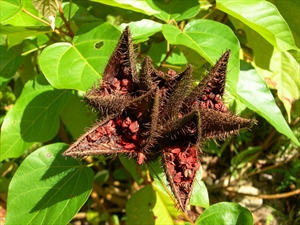- Worldwide distribution. On many kinds of beans. An important pest.
- Eggs are laid singly on leaves; the ant-like nymphs hatch, moulting to 16-18 mm long dark brown adults.
- Nymphs and adults use long, needle-like, mouth parts to suck juices from seeds causing pods to turn brown, shrivel and die.
- Cultural control: do not plant next to older crops where bugs are present; plant Bixa nearby as a trap crop; handpick in early mornings; collect and burn remains of the crop after harvest.
- Chemical control: sprays PDPs: derris, pyrethrum or chilli; synthetic pyrethroids or malathion.









